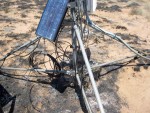In June 2009 I was meeting with biologist Jon Erz at the Sevilleta National Wildlife Refuge when I learned about their plans to conduct a 1600 hectare management burn in summer 2010 on the northern half of McKenzie Flats. This was an area of desert grassland that has not burned for decades. The southern boundary of this management burn would be just north of several of our long-term monitoring and experimental sites.
At the time I reiterated our desire to keep that part of the Refuge free from prescribed fires because we needed large areas of unburned grassland for reference sites. And besides, I said, it is nice to have a section of grassland available for natural, lightning caused fires since they are often quite patchy and generally burn fairly small areas, unlike the relatively large fire planned for 2010.
On 4-5 August 2009, while attending the Ecological Society of America meeting in Albuquerque, I was informed that multiple dry lightning strikes, high winds, and hot temperatures had combined to start a wildfire that ultimately burned about 3200 hectares, including the proposed 2010 management burn area. The fire started near the southern portion of McKenzie Flats and quickly burned through graduate student Michell Thomey's rainout shelters, the monsoon rainfall manipulation experiment, the grassland drought plots, and the small mammal exclosure experiment. Some of our small mammal trapping webs and net primary productivity (NPP) plots were toasted, as well.
The fire eventually burned north all the way to Black Butte and then east to the main access road. In the process it managed to burn through more of Michell's rainout shelters, partially through the warming experiment, and much of our NutNet experiment. It seems that the only places that didn't burn were a 15x15 meter area around the grassland flux tower, sparing all instrumentation and solar panels, and the fire seasonality experiment.
As Rahm Emanuel once (reportedly) said, never let a good crisis go to waste. In response to the unexpected fire, we plan to test a set of hypotheses on recovery dynamics and microbial-plant-consumer linkages under experimental climate change in this recently burned desert grassland. We are also discussing cross-site collaborations with the Arctic (ARC) and Santa Barbara Coastal (SBC) LTER sites that have also recently experienced wildfires, and the Konza Prairie (KNZ) LTER site, which has a regularly imposed experimental burning regime.

 Enlarge this image
Enlarge this image

